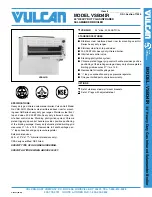
Mighty Max Hydronic Boiler
Page 5
not require the full freeze protection of a 50%/50%
mixture, it is beneficial to use a maximum 30% glycol
solution. This mixture will protect the boiler to
temperatures of about 5°F (-15°C), and will serve as
burst protection for boilers that are not in use.
2E. Installation of Indoor Boilers
2E-1. Combustion Air Supply and
Ventilation
There are a variety of options available to the
installer when it comes to venting and combustion air;
venting can be vertical or horizontal, it can originate
at the top of the boiler or the back, and combustion air
can be obtained from the room where the boiler is
installed or ducted directly to the boiler from
outdoors. See Sections 2J through 2M for details.
2E-2. Removal of Existing Boiler
At the time of removal of an existing boiler, the
following steps shall be followed with each appliance
remaining connected to the common venting system
placed in operation, while the other appliances
remaining connected to the common venting system
are not in operation.
1.
Seal any unused openings in the common
venting system.
2.
Visually inspect the venting system for proper
size and horizontal pitch and determine there is
no blockage or restriction, leakage, corrosion
and other deficiencies which could cause an
unsafe condition.
3.
Insofar as is practical, close all building doors
and windows, and all doors between the space in
which the appliances remaining connected to the
common venting system are located and other
spaces of the building. Turn on clothes dryers
and any appliance not connected to the common
venting system. Turn on any exhaust fans, such
as range hoods and bathroom exhausts so they
will operate at maximum speed. Do not operate a
summer exhaust fan. Close fireplace dampers.
4.
Place in operation the appliance being inspected.
Follow the lighting instructions. Adjust
thermostat so appliance will operate
continuously.
5.
Test for spillage at the draft hood relief opening
if the appliance is equipped with a drafthood,
after 5 minutes of main burner operation. Use
the flame of a match or candle, or smoke from a
cigarette, cigar or pipe.
6.
After it has been determined that each appliance
remaining connected to the common venting
system properly vents when tested as outlined
above, return door, windows, exhaust fans,
fireplace dampers and any other gas-burning
appliances to their previous condition of use.
7.
Any improper operation of the common venting
system should be corrected so the installation
conforms with the National Fuel Gas Code,
ANSI Z223.1. When resizing any portion of the
common venting system, the common venting
system should be resized to approach the
minimum size as determined using the
appropriate Tables in Appendix G in the
National Fuel Gas Code, ANSI Z223.1.
In Canada, at the time the boiler is removed from
common venting system, the common venting system
should be resized so the installation conforms to
CAN/CGA B149.1 or .2.
2E-2. Removal of Existing Boiler
Au moment du retrait d’une chaudière existante,
les mesures suivantes doivent être prises pour chaque
appareil toujours raccordé au système d’evacuation
commun et qui fonctionne alors que d’autres appareils
toujours raccordés au système d’évacuation ne
fonctionnent pas:
1.
Sceller toutes les ouvertures non utilisées du
système d’évacuation.
2.
Inspecter de façon visuelle le système
d’évacuation pour déterminer la grosseur et
l’inclinaison horiztonale qui conviennent et
s’assurer que le système est exempt
d’obstruction, d’étranglement, de fuite, de
corrosion et autres défaillances qui pourraient
présenter des risques.
3.
Dans la mesure du possible, fermer toutes les
portes et les fenêtres du bâtiment et toutes les
portes entre l’espace, où les appareils tojours
raccordés et les autres espaces du bâtiment.
Mettre en marche les sécheuses, tous les
appareils non raccordés au système d’évacuation
commun et tous les ventilateurs d’extraction
comme les hottes de cuisinère et les ventilateurs
des salles de bain. S’assurer que ces ventilateurs
fonctionnent à la vitesse maximale, Ne pas faire
fonctionner les ventilateurs d’été. Fermer les
registres des cheminées.
4.
Mettre l’appareil inspecté en marche. Suivre les
instructions d’allumage. Régler le thermostat de
façon continue.
5.
Faire fonctionner le brûleur principal pendant 5
min ensuite déterminer si le coupe-tirage
déborde à l’ouverture de décharge. Utiliser la
flamme d’une allumette ou d’une chandelle ou la
afumée d’une cigarette, d’une cigare ou d’une
pipe.
6.
Une fois qu’il a été déterminé, selon la méthode
indiquée ci-dessus, que chaque appareil raccordé






































